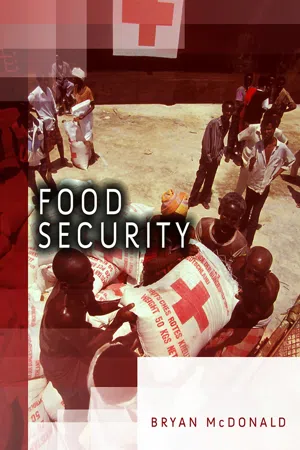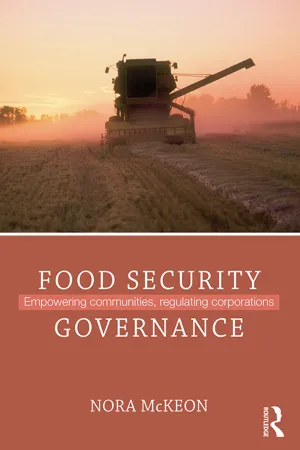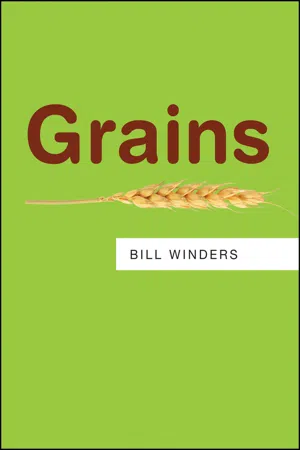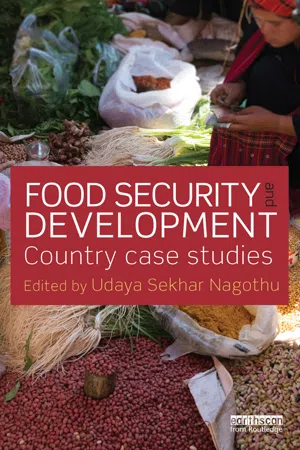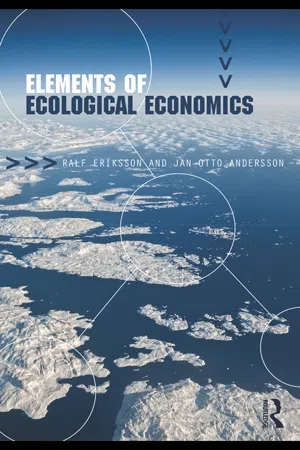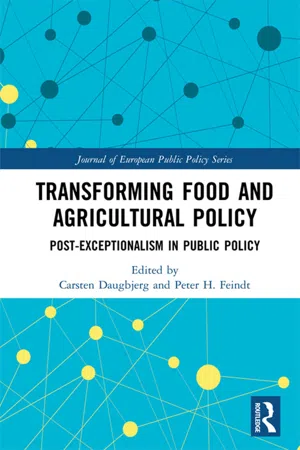Geography
Feeding the World
"Feeding the World" refers to the global challenge of providing food for the Earth's growing population. It encompasses issues such as food security, agricultural productivity, distribution systems, and sustainable farming practices. Geographers study the spatial distribution of food production, trade patterns, and the impact of environmental factors on food availability to understand the complexities of feeding the world's population.
Written by Perlego with AI-assistance
7 Key excerpts on "Feeding the World"
Learn about this page
Index pages curate the most relevant extracts from our library of academic textbooks. They’ve been created using an in-house natural language model (NLM), each adding context and meaning to key research topics.
- eBook - ePub
- Bryan L. McDonald(Author)
- 2013(Publication Date)
- Polity(Publisher)
While the increasing speed, scale, and density of food production practices have had significant impacts on the global environment, these processes have also resulted in tremendous gains in human well-being and livelihoods. Improvements in food and agricultural production have allowed not just for an increase in the number of people on the planet, but also general improvements in diet and human health, including significant reductions in chronic malnutrition (Fogel 2004). Since the global food crisis of the 1970s, the speed, scale, and density of interactions in food and agricultural production systems have been accelerated by the globalization process and, as discussed in chapter 1, have resulted in the rise of a network of global food systems. Recent global experiences with food price crises and global economic disruptions have once again focused attention on the significant challenges that remain to making certain that all people have enough food to lead healthy lives. But, as will be discussed in the next chapter, the world has begun to change economically and demographically and these processes of global change are dramatically transforming the food security landscape. Trends such as global population growth, urbanization, changing patterns of production and consumption, and global climate change pose considerable challenges to ensuring food security. - eBook - ePub
Food Security Governance
Empowering Communities, Regulating Corporations
- Nora McKeon(Author)
- 2014(Publication Date)
- Routledge(Publisher)
Food Provision in a Globalized WorldIn the preceding chapter we conducted a rapid historical review of the evolution of global food governance during the past decades and identified the actors, interests, and concepts that have animated the scene over time. This chapter will take a horizontal look at how the different players involved with food are linked with one another. Keeping in mind the basic questions raised in the introduction, we will seek to understand what determines the way in which the pieces are joined up and who benefits from the resulting assemblage.Food systems, chains and webs: terms and the meanings behind them
Over the first eons of humanity’s existence producers and consumers were a single category, although different food-related roles were played by different members of the family unit with men doing the hunting, women and children most of the gathering, and women the food preparation. The development of sedentary agriculture based on domestication of wild plants in the Fertile Crescent some 10,000–12,000 years ago furnished the basis for further differentiation of roles (Mazoyer and Roudart 2002, pp. 63–65). The agricultural surpluses produced by concentrated investment of labor, the introduction of water control, and breeding of species for desired traits made it possible for some people to specialize in nonagricultural artisanal activities and, progressively, for warrior and priest classes to be formed. Since then the cast of characters in what is commonly called a “food system”1 has multiplied and become more complex. Producers are always still consumers, of course, but consumers are often not direct producers. A host of other actors have inserted themselves upstream and downstream of production and interact with each other in arenas that range from the local to the global.A food system includes at a minimum the set of activities involved in producing food, processing and packaging it, distributing and retailing it, and consuming it. In order to be able to analyze the dynamics of how the system functions, it is also necessary to consider the “drivers”, or factors that provide impetus for these activities and their social, environmental, and food security outcomes (Ingram et al. 2010, p. 27). A recent FAO report on food systems groups their different components into three phases: i) production “up to the farm gate” (R&D, inputs, production, farm management), ii) postharvest supply chain “from the farm gate to the retailer” (marketing, storage, trade, processing, retailing), and iii) consumers (advertising, labeling, education, safety nets). It warns against thinking of these elements in linear fashion and emphasizes, instead, that the actors responsible for them interact and influence each other and that they function within broader economic, social, cultural, environmental, and policy contexts (FAO 2013b, pp. 7–8). The graph below, taken from an earlier FAO publication, is a good starting point since it provides a rather elementary but clear depiction of different aspects of food systems. We will encounter more complex representations further along in this chapter. - A variety of factors – including wars, natural disasters, and extreme weather – may reduce food security by decreasing a population’s access to food or by reducing the supply of food. Food security and world hunger, however, are more complex than simply increasing the aggregate food supply. For example, Craig Jenkins and Steven Scanlan point out that “Despite the ‘green revolution’ and the significant growth in international food aid and assistance, between 1970 and 1990 almost half of the world’s less developed countries (LDCs) suffered a decline in aggregate food supply, and more than a quarter suffered from an increase in child hunger.” 24 Even with increased use of agricultural technologies, increased agricultural production in the world, and increased food aid, the supply of food in many countries still declined. Thus, we need to ask what other factors lay behind the availability, accessibility, and even the supply of food. In particular, we need to examine grain markets and the geopolitics of grains. Agricultural Exports and Food Security Food security is frequently seen as an issue of food production and food imports. The export of grains, for example, is generally not seen as a detriment to food security. Rather, the export of grains or other food is seen as having a couple of important benefits. First, such exports help to facilitate the development of agriculture by drawing resources in the form of investments, since export agriculture generates revenues. Second, agricultural exports increase national income and allow for greater food imports. In this perspective, Brazil is often held up as a model of development. Brazil has substantially increased its agricultural production and exports at the same time that food insecurity has decreased within the country. This perspective on food exports, however, has significant problems
- eBook - ePub
Food Security and Development
Country Case Studies
- Udaya Sekhar Nagothu, Udaya Sekhar Nagothu(Authors)
- 2014(Publication Date)
- Routledge(Publisher)
Food Policy for Developing Countries , Pinstrup-Andersen and Watson (2011) use Ericksen’s (2008) notion of food systems as complex, dynamic systems filled with heterogeneous subsystems affected by nonlinear feedbacks as a basis for their analysis. The nonlinearity of the system’s feedback means that a small shock may have one or multiple effects, in contrast to a linear system where effects are always directly proportional to cause. Rather than attempting to isolate and study single causes of food insecurity (e.g. low agricultural output), it is more important to look at forces shaping the food system.The three main challenges the world will face in the coming decades are population growth, economic growth and climate change (FAO, 2009a; UN, 2010; Nelson et al. , 2011). These developments will have a direct impact on food security across the world, in varying degrees (Beddington et al. , 2012; Vermeulen et al. , 2012). Other factors such as technology, food wastage, land degradation, soil and water scarcity, urbanization, shift in trade patterns, migration of people from rural to urban areas, marginalization of women, and policymaking and political instability will affect food systems. With current trajectories, large regional differences in environmental and economic changes will continue to increase divides between the rich and poor. Coastal and mountainous areas and arid regions will be more vulnerable to future impacts from climate change than other regions. The rural poor and women, in particular in the sub-Saharan Africa and the Asia-Pacific regions, will be most affected. A recent report by Cameron et al . (2013) suggests that climate change is an issue of injustice and the likelihood that it might undermine the rights of people, especially the poor, marginalized and vulnerable, and influence future climate negotiations.Environmental changes and food production
Inefficient food systems (production, distribution and wastage) negatively impact the environment, especially land and water resources, and vice versa (IPCC, 2007). Despite the claims that the Green Revolution lifted millions of poor farmers out of poverty, it has also been widely criticized for causing widespread environmental damage to water bodies, forests and biodiversity due to excessive and inappropriate use of fertilizers and pesticides (Hazell and Haddad, 2001; Mosley, 2003). Environmental impacts of agricultural intensification, although not easily observed, tend to have significant long-term effects on food production and food supply. Increased demand for food will most likely lead to further deforestation, biodiversity depletion and soil erosion, water scarcity and intensified use of fertilizers and chemicals, which may in turn increase emission of greenhouse gases and pollution. According to the IAASTD report (2008), social and economic inequities, political uncertainties and changing environmental conditions demand a new approach to sustainable production and consumption at all levels. There are, nevertheless, enormous opportunities to develop food systems that are more environmentally benign, that can be low-cost and efficient in terms of resource use and productivity if the right political will and resources are available (Government Office for Science, 2011). - eBook - ePub
- Jan Otto Andersson, Ralf Eriksson(Authors)
- 2010(Publication Date)
- Routledge(Publisher)
world market for food – in which a large part of the population is overfed, at the same time as many live under conditions of chronic hunger and occasional famine.The determinants of food production
Food production growth is the combined result of growth of the harvested area and of yield growth – it is the increase in land productivity . Since most arable land is already in use, the increase in food production – measured in terms of tons, calories or value – has primarily come as a result of increased yields per hectare. Area expansion had ceased to be a feasible source of crop production growth by the end of the twentieth century, except for parts of Latin America and Africa, where rural population densities are still relatively low. In many poor areas there is still pressure to clear land for cultivation, and this is one important reason for deforestation . However, such an expansion of agricultural land cannot solve the problems of the rising demand for food. The crucial factor is the potential increase in productivity per hectare.Yield is a function of several variables: soil quality, weather conditions, labor use, type of seed, fertilizers, herbicides and pesticides, irrigation, tractors and other machinery, as well as the abilities of the farmers. Productivity indirectly depends on how food production is linked to the rest of society through roads, markets, land ownership, prices, education, subsidies and much more.Although the direct contribution of agriculture to GDP has dwindled during the past 50 years – and is globally no more than 4 percent – its economic, social and ecological importance is still much stronger. The different types of inputs required and the varied and extensive use of its outputs makes agriculture a central component of most national economies. One of the best indicators of the degree of development of a country is the value produced per farmer - eBook - ePub
Population, Agriculture, and Biodiversity
Problems and Prospects
- J. Perry Gustafson, Peter H. Raven, Paul R. Ehrlich(Authors)
- 2020(Publication Date)
- University of Missouri(Publisher)
At a global level, food production is, generally speaking, still within the surplus zone. This means that enough food is being produced for the world’s people. This is as a result of the recent rapid increases in production due to land conversion and the use of chemicals and improved technologies. The current challenge is not food shortage per se, but its distribution (i.e., getting the agricultural produce from the surplus to the deficit zones in an affordable, fast, and efficient manner while maintaining food quality). Access is thus the issue, not production. This scenario, however, is likely to come to an end sooner rather than later. We’re facing an era where society will be faced with the double challenge of distribution and shortage. Under such a scenario the distribution of food is likely to become a game of political, institutional, and economic power to the point of potential outright conflict. Why? If society cannot meet the challenge of appropriate and adequate food distribution within times of surplus, imagine a time of shortage.The mentioned shortage is as a result of both supply and demand side factors. From the supply side, changes in climatic patterns and increasing resource constraints are the dominant factors. Some of the resource constraints are self-induced as a result of the wasteful way in which agriculture has been practiced over the last few decades leading to erosion, to unsustainable linear supply system of nutrients and chemicals, and to concomitant contamination of soils and water bodies. These negative externalities and their consequences are tied directly to the past success within the agricultural sector. From the demand side it should come as no surprise that the demand for food is rising as a result of, among other factors, a growth in income, changing dietary patterns, and an increase in population.Given both the supply and demand factors, the pressures on agriculture are rapidly rising—and that within an ever-increasing cauldron of vested interest and power. This leaves the decisionmaker, be it a farmer, a regional institution, a national government or the global society, with, broadly speaking, four possible response options leading to four scenarios or “future trajectories.” Within each context, the decisionmaker has to select the most appropriate agricultural practice within the constraints of climate change and resource limitations. While some factors are beyond the scope of influence of an individual decisionmaker, this is not so regarding the decision with respect to the farming method applied. That is within the decisionmaker’s domain of influence. - eBook - ePub
Transforming Food and Agricultural Policy
Post-exceptionalism in public policy
- Carsten Daugbjerg, Peter Feindt(Authors)
- 2019(Publication Date)
- Routledge(Publisher)
‘Feeding 9 billion people’: global food security debates and the productionist trap Eve Fouilleux, Nicolas Bricas and Arlène AlphaABSTRACT Food security, a long-established item on the international agenda, raises many issues including production, consumption, poverty, inequalities, healthcare and conflicts. However, in 2007/2008 the global food security debate was relaunched with a single dominant focus which continues to the present day: increasing agricultural production. This paper explains this productionist bias – which may translate into inadequate policies – by combining insights from institutionalist and cognitive analyses. We show that, despite recent reforms, the global food security field remains dominated by macro- and micro-institutions that put food availability and agricultural production at the heart of the problem and solutions. The political and discursive strategies developed by transnational corporations and private foundations to promote their productivist interests are also key, along with the demands of dominant farmers’ unions in exporting countries. Although advocating opposite development patterns, civil society actors implicitly reinforce the productionist perspective through their focus on family agriculture.Introduction‘Food security’ is anything but a new issue on the international stage. It has been institutionalized since the post-1945 period through various international organizations. The term itself appeared during the 1970s and its conceptual content has evolved over time. The most commonly accepted definition was officially established by the 1996 World Food Summit: food security exists when ‘all people, at all times, have physical and economic access to sufficient safe and nutritious food that meets their dietary needs and food preferences for an active and healthy life’. Food security/insecurity is a complex topic covering many dimensions, such as poverty, inequality, unemployment, prices, consumption habits and culture, gender and nutrition. Food insecurity causes can vary tremendously among areas, social groups or individuals.
